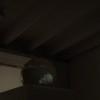

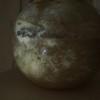

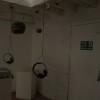


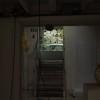

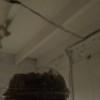


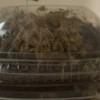
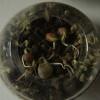
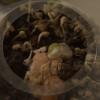

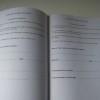
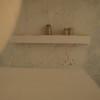

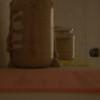
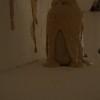

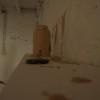
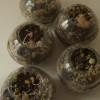

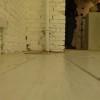
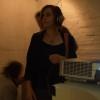
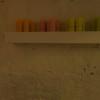


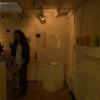
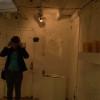


Barbara Boiocchi, Emma James, Valerie Furnham & Pia Galvez
Sourdough (wheat flour, water, microorganisms, fermentation), soil, sprouts, glass
Site-specific installation
Variable dimensions
2014
Description
Exploration
Our site-specific collaborative project would not have popped-up without the debates and bonds created through the residency talks and exchanges, or without the understanding of it as an immersive opportunity to cooperate with like-minded artists with different backgrounds.
The collaborative experience of artists working together echoes the approach required to conduct sustainable activities. The very act of working together nurtures a mutual respect and perception of the other as equal to oneself and thus worthy of notice and consideration. It is this attitude and appreciation of our surroundings, fellow people, activities and customs, that engenders sustainable situations. By considering how we choose to live, how we choose to act and the effect it has on everything living and existing around us, it is possible to achieve balance.
Unbalance is the direct result of one side becoming too dominant, and by its very nature, an unbalanced situation is an unstable one. Long-term and will not last indefinitely. Long term inattention to sustainability as a life choice can tip the balance, resulting in a sense that living in a mindful sustainable manner seems to be small and insignificant and not worthy of notice. Everything that is done towards adressing this imbalance pushes the possibility of sustainability further forward.
The goal of sustainability often appears to be so large as to be unachievable and with this thought it is easy to decide it is impossible, so not worth attempting. If each of us had started out at the beginning of the residency knowing we had to achieve all we did achieve in the installation, it could have seemed daunting and unachievable for one artist working alone. Working in a collaboration made all we achieved easy and enjoyable and allowed us to each achieve more than we could have done separately, sharing information, ideas and enthusiasm in a sustainable manner and achieving a balance which would not have been possible alone.
During the Global Sustainability Institute (GSI ) talk it was mentioned that the three pillars of sustainable development reflecting the 80’s vision under the umbrella of ‘Our Common Future’ (Brundtland et al.,1 987) are being updated. Economic growth, social inclusion and environmental balance are not enough in our times; the call nowadays is for the inclusion of culture as the fourth pillar of sustainability. ‘The Limits to Growth’ model is also being updated, which means, at least, a reconsideration of global freshwater and points to a need for a land system to be implemented (Meadows et al., 1 972).
Another important inspiration was the CamBake project. The Cambridge Community Bakery’s aim is to provide sourdough bread with locallysourced flour. Their bread is leavened using naturally occurring yeasts within the flour.
A valuable discussion with researchers from the GSI revealed personal batles in people’s minds about who sustainability is for. Is it about making the Earth sustainable in its own right and keeping the conditions for diverse life or is sustainability for our own personal survival as humans?
They are interconnected. We rely on the ecosystem the planet has to offer, which is only possible with the fine balance of species in an environmental equilibrium. The conclusion of this debate, though, was that we are knowledgeable about this cause and effect. We know what we are doing to our own species and to the planet and because of this knowledge we have a choice. As Robin McKie writes in his review of ‘The Sixth Extinction: An Unnatural History’ by Elizabeth Kolbert;
“the crucial point about the current extinction is that the agent involvedis not an inanimate object ora geological force but a living creature, Homo sapiens.”
In poetical terms, it could be said that art belongs to culture in as much as culture belongs to human beings. Expanding this poetic licence, it could be said that there is also a ‘bread culture’, which has the double meaning of being both a staple food for many civilizations as well as a reference to yeast.
Other inputs appeared during the discussion and review with Sergio Fava were: water; involvement; audience as performer and not as an observer; giving something to people that involves time; yeast culture; duration; time as social convention versus natural time.
Our relationship with sustainability seems to be pinned on our relationship to the concept of time. What is the time frame in which we are to be sustainable? What are we trying to sustain? The world? Other species? The individual? The human race? Politics and the economy? Sustainability of all these ecologies requires an engagement on very different time scales. The GSI works on sustainability within a time frame of five years, the time in which our politics works; and their responses are in the form of data (rational response), not art (emotional response). This seemed, to a group of us, in contradiction to our experience of the landscape, a landscape that exists and develops in what is known as deep time, defined as:
“the multimillion year time frame within which scientists believe the Earth has existed, and which is supported by the observation of natural, mostly geological, phenomena.”
Deep time is a time frame that extends beyond human history, making it a hard concept to comprehend. Yet to understand sustainability we must understand the time frame in which the Earth operates. Can our understanding of time incorporate the magnitude of deep time? Ancient civilizations evolved around an understanding of deep time. From Stonehenge, the Inca temples, the Pyramids to a passage tomb in Newgrange, Ireland, humans have built structures that celebrate and connect with the planet’s time frame. But with the development of our clock, we have structured time to a smaller scale and we are only reminded of the change of the seasons by the change from GMT to BST. We carry about with us an instrument to measure the passing second while ignoring the millions of years before and after. So what does time really mean for us? In ‘In Search of Time’ John Shea says that time is the:
“ability to perceive the future in terms ofcontingencies”,
in terms of
“if this, then that will happen”.
Time is about cause and effect, our ability to predict. As the knowledge of our environment increases at a fast rate, our ability to predict has taken us back to reconnect with the concept of deep time as we predict our own demise as a species, or use prediction as the ultimate sustainability tool.
During the weekend, we came across the book ‘Fungal biology in the Origin and Emergence of Life’ (Moore, 201 3). Within the book was the relevant quotation:
“The rhythm of life on Earth includes several strong themes contributed by kingdom Fungi. So why are fungi ignored when theorist ponder the origin of life?”
The book also mentioned other ideas that widen our approach, for example, the kingdoms for the living organisms on Earth are: animals, plants, bacteria, proteins and fungi, the Earth is 4.6 billion years old, humans are 200,000 years old and fungi are 500,000,000 years old and that the yeast is an eukaryotic single-celled fungi.
The knowledge of our environment and where it comes from seems an important factor in how we reconnect with deep time. When Bob Evans came in to talk to us about his research into soil he gave a glimpse of his vision of a Utopian farming method. He spoke of man replacing the machine and offered the idea of a form of conscription, where everyone at the age of 1 8 would spend one year tending the land and gathering crops. This brought forward the idea of disconnection with our environment and hence, reintroducting the cycles of the landscape, the seasons, the light, the weather, became an underlying feature our collaboration. This process seemed to align with our process of tending the yeast, involving daily keeping the right temperature.
Bob Evans mentioned that the loss of soil has a big impact on crops, and he pointed out that when the soil is washed away every time it rains, the chemicals and fertilisers are also washed away, becoming a major source of pollution. The basis of his work is observation and we commonly use that methodology.
Yeasts are fungi that can be at the origins of life. Yeast is a living and natural product and heritage. To make sourdough bread the yeast ferments the flour. Flour comes from grain; we need a fertile soil in which to plant a cereal, along with water and sun. The sun is at the heart of our solar system, the macrocosm. The fungi, compared to the solar system could be considered, the microcosm.
Installation
There are wild yeast spores floating in the air: Or os this a myth? If it is true we can have site-specific yeast depending on where we feed it. We fed the yeast at the gallery. The center of the site-specific installation was a fishbowl filled with that yeast. The yeast was then on a plint, an altar and centre of our cosmos. The fishbowl was a container that reminded us of the relationship with a pet (you have to feed the yeast) and a sphere that evoked the microcosm and macrocosm.
Recorded loops of the amplified sound of the sourdough living and growing, normally inaudible, could be heard from hanging headphones around the fishbowl. The projections onto it, showing its fermentation, represented the microcosm. The macrocosm was represented by several hanging spheres orbiting around the fishbowl filled with soil containing sprouts from different cereals and yeast to enrich the soil.
To guarantee the ‘audience’ as performer and not observer, we first walked around the city asking people in the streets of Cambridge about their feelings and actions concerning sustainability. Thinking – learning – feeling are actions that require the investment of a different time from the one we use to produce something material. These actions come from the answer to the request ’Give me three example of things you do in your daily life which are sustainable.’ These actions create another kind of deep time, which respects the natural pace of growth that one devotes to one’s own evolution: a time when the human is at the centre and pays attention to his or her feelings about contributing to the community and the surrounding environment. This action grew out of the idea that time is money that can be exchanged for things: ‘Quid Pro Quo: Negotiating Futures’. Every person who answered spent time on the topic of sustainability, triggering instant responses that may be food for thought in the future. Those 20 papers with handwritten answers on one side allowed us to cover 20 jars filled with the specially prepared yeast. We handwrote on the other side of the paper the instructions for looking after the sourdough. The jars were a present only available during the inauguration. To obtain the jars, people were asked to answer the same survey and signed a certificate of commitment to look after the sourdough. Thanks to them we started a chain with 20 new surveys, that we are able to use to repeat the process in the future.
To enable the viewer to become part of the artwork was one intention, and by being involved in the experience of the installation the viewer became aware of the Sourdough Starter as a life form and a giver of life and sustenance. The acceptance of the responsibility of nurturing a jar of the Sourdough Starter and the symbolic and actual signing of the book as recognition of that commitment to another life, brought them into the circle of sustainability and engendered a respect for this life and what it freely offers.
In the piece ‘Deep Time’ the process of nurturing for the yeast made the invisible air into a living, breathing, tangible creature. The invisible became visible, altering our idea of yeast as an inanimate substance and making it into a living ‘pet’ that each person, when leaving the gallery, was conscripted to take care of. Time has become the common thread of our site-specific collaborative project, activating a process of awareness and care in the ‘audience’.
Exhibition
Quid Pro Quo: Negotiating Futures
10 – 13 April
Changing Spaces (Cambridge, United Kingdom)
